NISSAN 370Z 2020 Owner´s Manual
Manufacturer: NISSAN, Model Year: 2020, Model line: 370Z, Model: NISSAN 370Z 2020Pages: 455, PDF Size: 2.22 MB
Page 431 of 455
![NISSAN 370Z 2020 Owner´s Manual Tire
TypeSize Pressure PSI (kPa) [Cold]
Conventional Front: 225/50R18 95W
Rear: 245/45R18 96W
35 (240)*2
38 (260)*3
Front: 245/40R19 94W
Rear: 275/35R19 96W 32 (220)
NISMO models Front: 245/40R19 98Y
NISSAN 370Z 2020 Owner´s Manual Tire
TypeSize Pressure PSI (kPa) [Cold]
Conventional Front: 225/50R18 95W
Rear: 245/45R18 96W
35 (240)*2
38 (260)*3
Front: 245/40R19 94W
Rear: 275/35R19 96W 32 (220)
NISMO models Front: 245/40R19 98Y](/img/5/40288/w960_40288-430.png)
Tire
TypeSize Pressure PSI (kPa) [Cold]
Conventional Front: 225/50R18 95W
Rear: 245/45R18 96W
35 (240)*2
38 (260)*3
Front: 245/40R19 94W
Rear: 275/35R19 96W 32 (220)
NISMO models Front: 245/40R19 98Y
Rear: 285/35R19 99Y 35 (240)
Spare (T-type) T145/80D17 107M*1
T145/70R18 107M*1
60 (420)
—*3, *4
*1: if so equipped
*2: Coupe models
*3: Roadster models
*4: The emergency tire puncture repair kit is supplied.
DIMENSIONS
in (mm)
Overall length 167.6 (4,255)*1 167.7 (4,260)*2
170.5 (4,330)*3
Overall width 72.6 (1,845) 73.6 (1,870)*3
Overall height 51.8 (1,315) 52.2 (1,325)*4
Front tread 61.0 (1,550)*5 60.6 (1,540)*6
61.2 (1,555)*6, *3
Rear tread 62.8 (1,595)*5
61.6 (1,565)*6
62.2 (1,580)*6, *3
Wheelbase 100.4 (2,550)
*1: Without front license plate bracket
*2: With front license plate bracket
*3: NISMO models
*4: Roadster models
*5: 18-inch wheel models
*6: 19-inch wheel models
Technical and consumer information10-11
Page 432 of 455
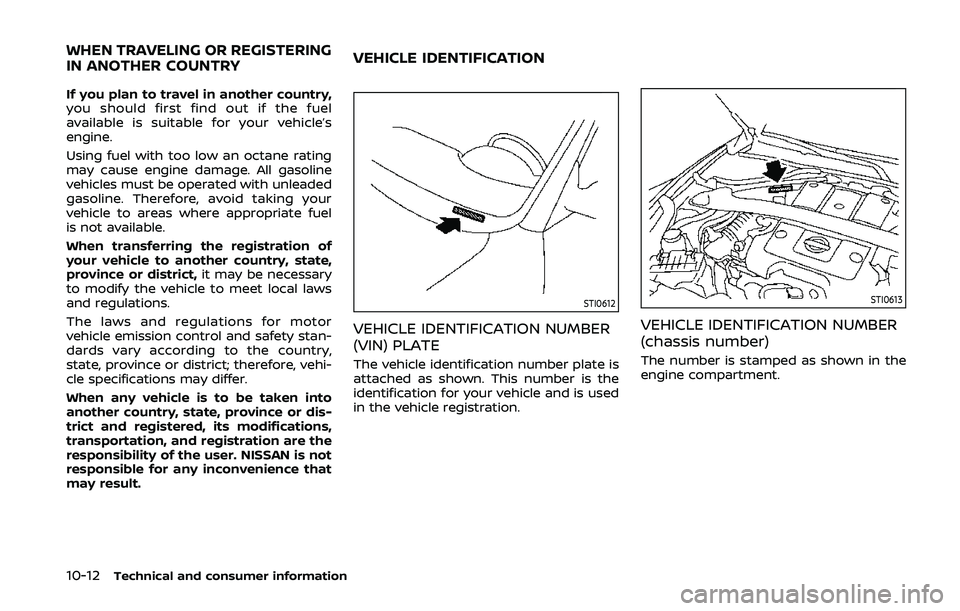
10-12Technical and consumer information
If you plan to travel in another country,
you should first find out if the fuel
available is suitable for your vehicle’s
engine.
Using fuel with too low an octane rating
may cause engine damage. All gasoline
vehicles must be operated with unleaded
gasoline. Therefore, avoid taking your
vehicle to areas where appropriate fuel
is not available.
When transferring the registration of
your vehicle to another country, state,
province or district,it may be necessary
to modify the vehicle to meet local laws
and regulations.
The laws and regulations for motor
vehicle emission control and safety stan-
dards vary according to the country,
state, province or district; therefore, vehi-
cle specifications may differ.
When any vehicle is to be taken into
another country, state, province or dis-
trict and registered, its modifications,
transportation, and registration are the
responsibility of the user. NISSAN is not
responsible for any inconvenience that
may result.
STI0612
VEHICLE IDENTIFICATION NUMBER
(VIN) PLATE
The vehicle identification number plate is
attached as shown. This number is the
identification for your vehicle and is used
in the vehicle registration.
STI0613
VEHICLE IDENTIFICATION NUMBER
(chassis number)
The number is stamped as shown in the
engine compartment.
WHEN TRAVELING OR REGISTERING
IN ANOTHER COUNTRYVEHICLE IDENTIFICATION
Page 433 of 455
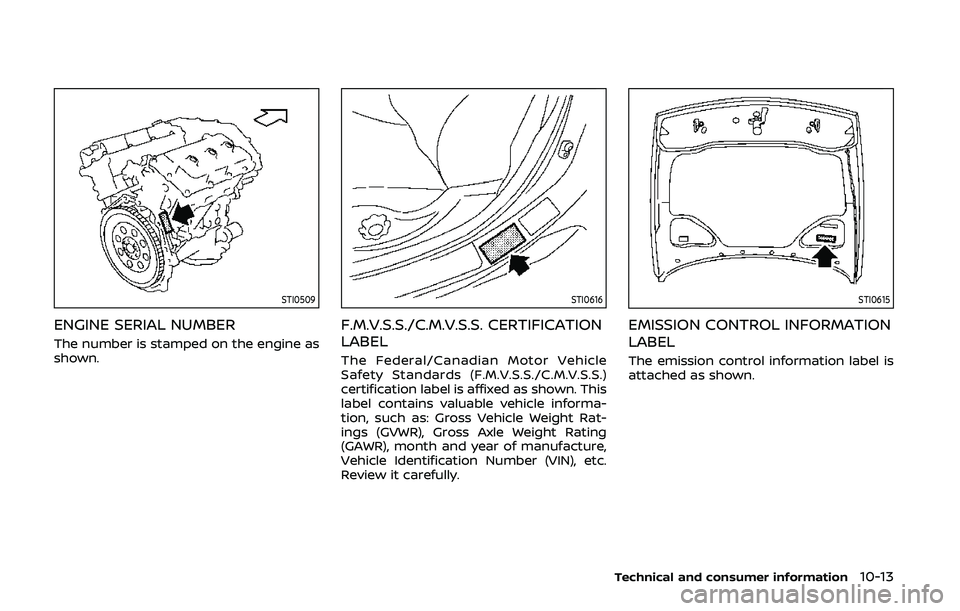
STI0509
ENGINE SERIAL NUMBER
The number is stamped on the engine as
shown.
STI0616
F.M.V.S.S./C.M.V.S.S. CERTIFICATION
LABEL
The Federal/Canadian Motor Vehicle
Safety Standards (F.M.V.S.S./C.M.V.S.S.)
certification label is affixed as shown. This
label contains valuable vehicle informa-
tion, such as: Gross Vehicle Weight Rat-
ings (GVWR), Gross Axle Weight Rating
(GAWR), month and year of manufacture,
Vehicle Identification Number (VIN), etc.
Review it carefully.
STI0615
EMISSION CONTROL INFORMATION
LABEL
The emission control information label is
attached as shown.
Technical and consumer information10-13
Page 434 of 455
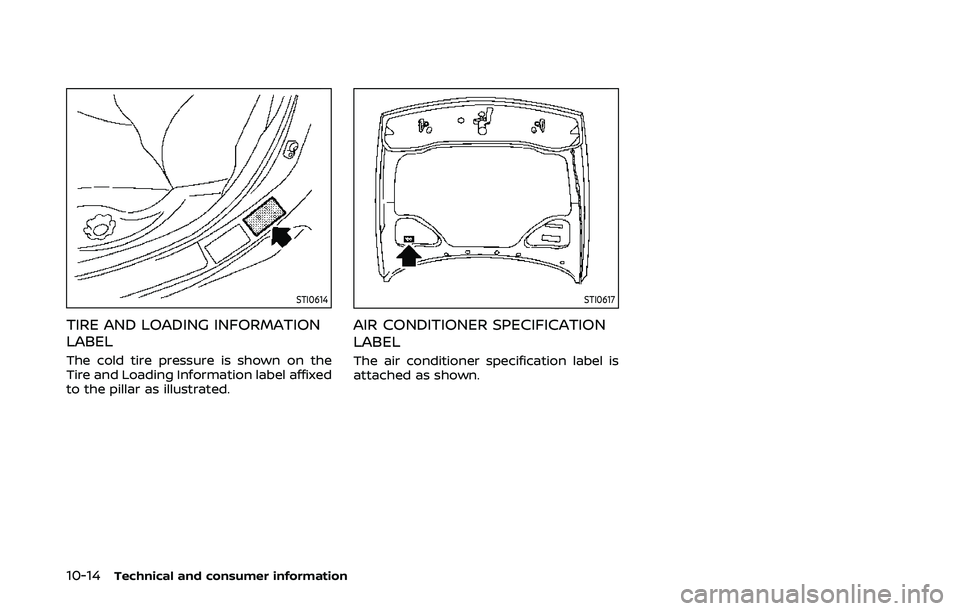
10-14Technical and consumer information
STI0614
TIRE AND LOADING INFORMATION
LABEL
The cold tire pressure is shown on the
Tire and Loading Information label affixed
to the pillar as illustrated.
STI0617
AIR CONDITIONER SPECIFICATION
LABEL
The air conditioner specification label is
attached as shown.
Page 435 of 455
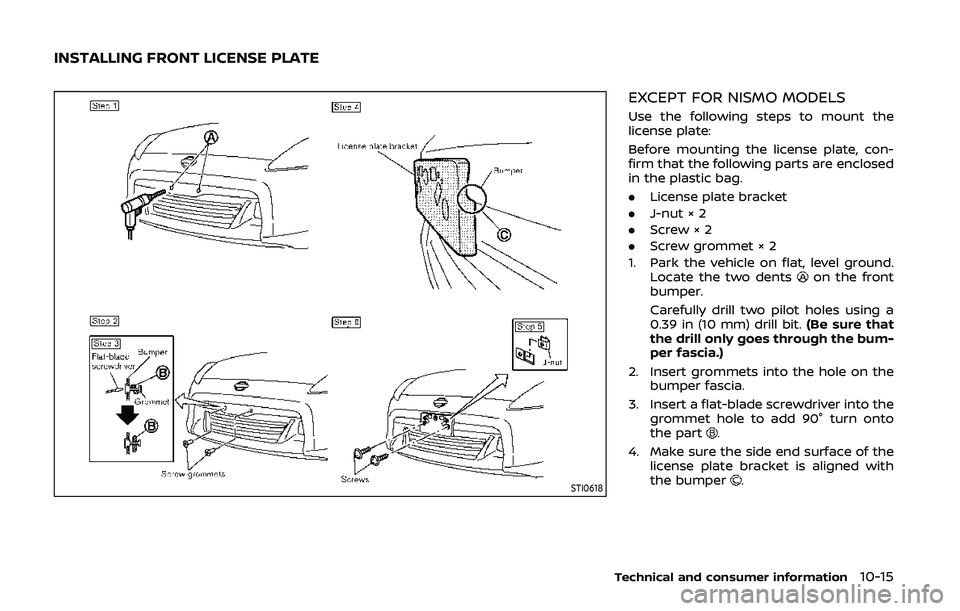
STI0618
EXCEPT FOR NISMO MODELS
Use the following steps to mount the
license plate:
Before mounting the license plate, con-
firm that the following parts are enclosed
in the plastic bag.
.License plate bracket
. J-nut × 2
. Screw × 2
. Screw grommet × 2
1. Park the vehicle on flat, level ground. Locate the two dents
on the front
bumper.
Carefully drill two pilot holes using a
0.39 in (10 mm) drill bit. (Be sure that
the drill only goes through the bum-
per fascia.)
2. Insert grommets into the hole on the bumper fascia.
3. Insert a flat-blade screwdriver into the grommet hole to add 90° turn onto
the part
.
4. Make sure the side end surface of the license plate bracket is aligned with
the bumper
.
Technical and consumer information10-15
INSTALLING FRONT LICENSE PLATE
Page 436 of 455
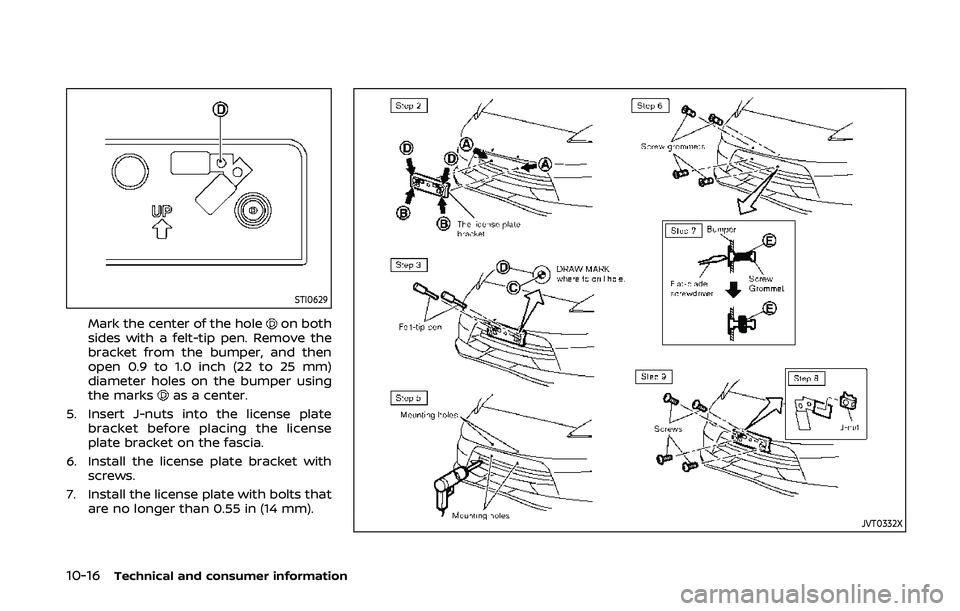
10-16Technical and consumer information
STI0629
Mark the center of the holeon both
sides with a felt-tip pen. Remove the
bracket from the bumper, and then
open 0.9 to 1.0 inch (22 to 25 mm)
diameter holes on the bumper using
the marks
as a center.
5. Insert J-nuts into the license plate bracket before placing the license
plate bracket on the fascia.
6. Install the license plate bracket with screws.
7. Install the license plate with bolts that are no longer than 0.55 in (14 mm).
JVT0332X
Page 437 of 455
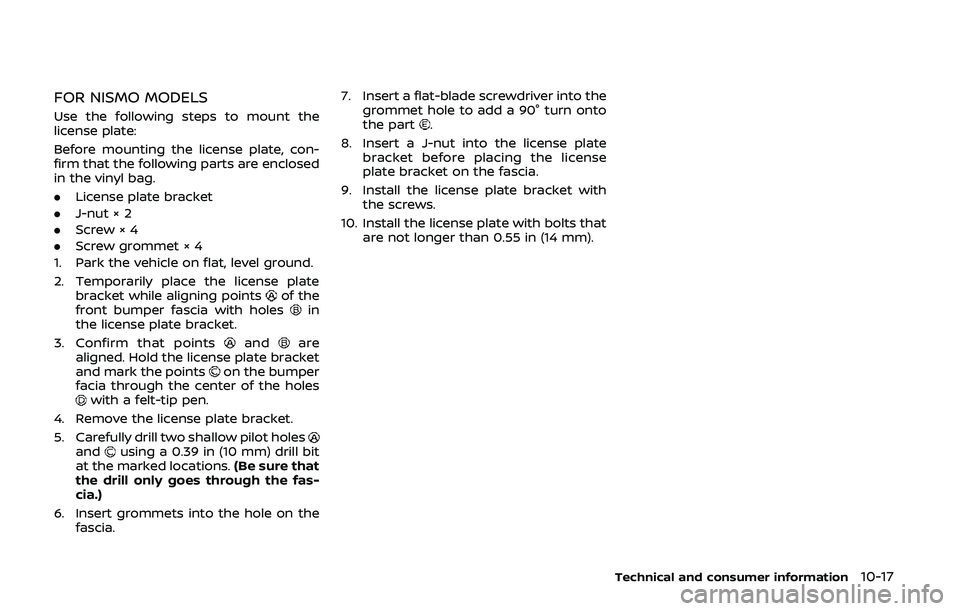
FOR NISMO MODELS
Use the following steps to mount the
license plate:
Before mounting the license plate, con-
firm that the following parts are enclosed
in the vinyl bag.
.License plate bracket
. J-nut × 2
. Screw × 4
. Screw grommet × 4
1. Park the vehicle on flat, level ground.
2. Temporarily place the license plate bracket while aligning points
of the
front bumper fascia with holesin
the license plate bracket.
3. Confirm that points
andare
aligned. Hold the license plate bracket
and mark the points
on the bumper
facia through the center of the holes
with a felt-tip pen.
4. Remove the license plate bracket.
5. Carefully drill two shallow pilot holes
andusing a 0.39 in (10 mm) drill bit
at the marked locations. (Be sure that
the drill only goes through the fas-
cia.)
6. Insert grommets into the hole on the fascia. 7. Insert a flat-blade screwdriver into the
grommet hole to add a 90° turn onto
the part
.
8. Insert a J-nut into the license plate bracket before placing the license
plate bracket on the fascia.
9. Install the license plate bracket with the screws.
10. Install the license plate with bolts that are not longer than 0.55 in (14 mm).
Technical and consumer information10-17
Page 438 of 455
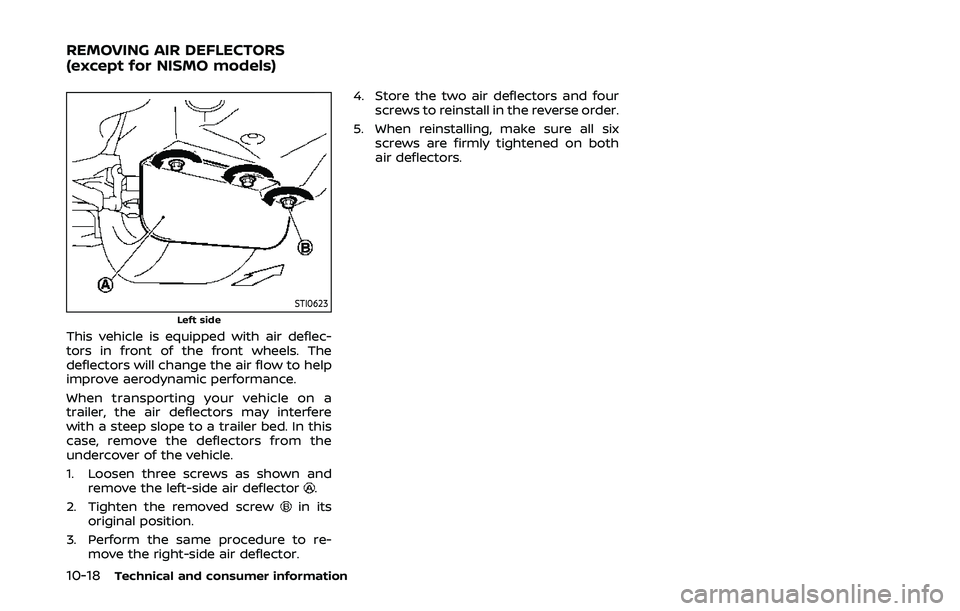
10-18Technical and consumer information
STI0623Left side
This vehicle is equipped with air deflec-
tors in front of the front wheels. The
deflectors will change the air flow to help
improve aerodynamic performance.
When transporting your vehicle on a
trailer, the air deflectors may interfere
with a steep slope to a trailer bed. In this
case, remove the deflectors from the
undercover of the vehicle.
1. Loosen three screws as shown andremove the left-side air deflector
.
2. Tighten the removed screw
in its
original position.
3. Perform the same procedure to re- move the right-side air deflector. 4. Store the two air deflectors and four
screws to reinstall in the reverse order.
5. When reinstalling, make sure all six screws are firmly tightened on both
air deflectors.
REMOVING AIR DEFLECTORS
(except for NISMO models)
Page 439 of 455
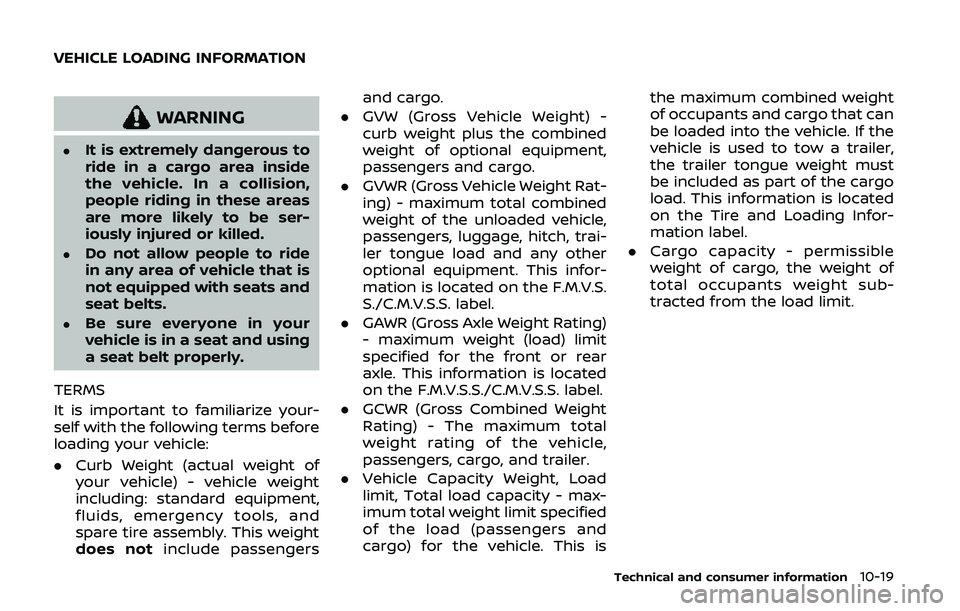
WARNING
.It is extremely dangerous to
ride in a cargo area inside
the vehicle. In a collision,
people riding in these areas
are more likely to be ser-
iously injured or killed.
.Do not allow people to ride
in any area of vehicle that is
not equipped with seats and
seat belts.
.Be sure everyone in your
vehicle is in a seat and using
a seat belt properly.
TERMS
It is important to familiarize your-
self with the following terms before
loading your vehicle:
. Curb Weight (actual weight of
your vehicle) - vehicle weight
including: standard equipment,
fluids, emergency tools, and
spare tire assembly. This weight
does not include passengers and cargo.
. GVW (Gross Vehicle Weight) -
curb weight plus the combined
weight of optional equipment,
passengers and cargo.
. GVWR (Gross Vehicle Weight Rat-
ing) - maximum total combined
weight of the unloaded vehicle,
passengers, luggage, hitch, trai-
ler tongue load and any other
optional equipment. This infor-
mation is located on the F.M.V.S.
S./C.M.V.S.S. label.
. GAWR (Gross Axle Weight Rating)
- maximum weight (load) limit
specified for the front or rear
axle. This information is located
on the F.M.V.S.S./C.M.V.S.S. label.
. GCWR (Gross Combined Weight
Rating) - The maximum total
weight rating of the vehicle,
passengers, cargo, and trailer.
. Vehicle Capacity Weight, Load
limit, Total load capacity - max-
imum total weight limit specified
of the load (passengers and
cargo) for the vehicle. This is the maximum combined weight
of occupants and cargo that can
be loaded into the vehicle. If the
vehicle is used to tow a trailer,
the trailer tongue weight must
be included as part of the cargo
load. This information is located
on the Tire and Loading Infor-
mation label.
. Cargo capacity - permissible
weight of cargo, the weight of
total occupants weight sub-
tracted from the load limit.
Technical and consumer information10-19
VEHICLE LOADING INFORMATION
Page 440 of 455

10-20Technical and consumer information
STI0365
VEHICLE LOAD CAPACITY
Do not exceed the load limit of your
vehicle shown as “The combined
weight of occupants and cargo” on
the Tire and Loading Information
label. Do not exceed the number of
occupants shown as “Seating Ca-
pacity” on the Tire and Loading
Information label.
To get “the combined weight of
occupants and cargo”, add the
weight of all occupants, then add
the total luggage weight. Examples
are shown in the illustration.Steps for determining correct load
limit
1. Locate the statement “The com- bined weight of occupants and
cargo should never exceed XXX
kg or XXX lbs” on your vehicle’s
placard.
2. Determine the combined weight of the driver and passengers
that will be riding in your vehicle.
3. Subtract the combined weight of the driver and passengers
from XXX kg or XXX lbs. 4. The resulting figure equals the
available amount of cargo and
luggage load capacity. For ex-
ample, if the XXX amount equals
1400 lbs. and there will be five
150 lb. passengers in your vehi-
cle, the amount of available
cargo and luggage load capacity
is 650 lbs. (1400 − 750 (5 x 150) =
650 lbs or 640 − 340 (5 x 70) =
300 kg.)
5. Determine the combined weight of luggage and cargo being
loaded on the vehicle. That
weight may not safely exceed
the available cargo and luggage
load capacity calculated in Step
4.
6. If your vehicle will be towing a trailer, load from your trailer will
be transferred to your vehicle.
Consult this manual to deter-
mine how this reduces the avail-
able cargo and luggage load
capacity of your vehicle.
Before driving a loaded vehicle,
confirm that you do not exceed